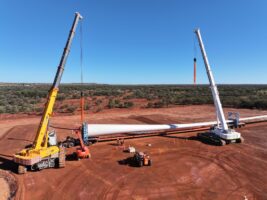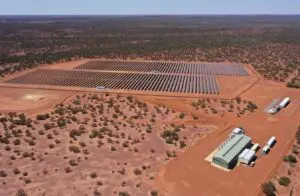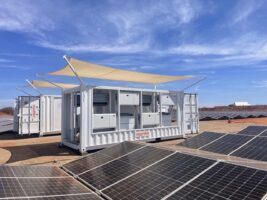Fresh concerns have emerged over the soaring cost of building new offshore wind energy projects, with reports that the latest UK government-backed renewable energy auction has priced the troubled sector entirely out of contention.
The British government set a maximum price of £44/MWh ($A86.10/MWh) for its latest tender for financial support for renewable energy generation contracts, for which developers were required to submit sealed bids in the first half of August.
Reports from industry this week have raised the prospect that – at that price – most offshore wind developers will have been forced to sit out of the bidding, due to surging project costs in the sector.
They are urging the government to lift that price if they want projects to go ahead. Already, one previous auction winner has pulled their project because they are no longer able to build at that prices.
According to industry sources cited by the Guardian on Thursday, it is possible that only one or two offshore projects submitted bids in the funding round – others suggest that none took part.
This is a major concern for the UK, which like so many other countries is scrambling to replace fossil fuels on its grid. A big part of this is expected to be offshore wind, and the national target of 50GW by 2030 leaves just seven years to add more than 36GW of new capacity.
The contagion is spreading to the US, where the biggest offshore wind developer, Orsted, is threatening to pull its projects and has been forced into massive write downs.
But it’s also a major red flag for countries like Australia, where the offshore wind industry is only just starting out, and therefore lacks any of the cost advantages that established supply chains can offer.
In Australia, with two offshore wind energy zones declared, and plans to create at least six, the assumption is that the build-out – starting from scratch in Victoria – will cost well over $100/MWh, not including transmission.
“I think we need to be realistic. It’s not going to be cheap,” said Niels Steenberg, the head of offshore wind development at Siemens Gamesa at the first offshore wind conference to be held in Australia by the global peak body, the Global Wind Energy Council.
“The first three to five gigawatts are going to be expensive to build, but once we get over that hurdle, I think (offshore wind) has shown consistently that it’s reliable and it’s dependable and, in today’s market, a cheap form of energy. But the first projects are not, we have to realise that and we need to support them.”
The consistent reports of derailed projects and manufacturer turmoil come at a bad time for Australia, as the industry gears up to “break ground” on its first ever project, likely the Star of the South in Victoria’s Gippsland zone.
As Tilt Renewables Anthony Yeats put it at the Australia Wind Energy conference in Melbourne in July, “it’s an inconvenient truth … that right at the point in time when the world is looking to our industry to be able to roll out and to increase the rollout of energy, the competition for supply … and for people is driving prices up.”
Even in the US, with the benefit of the Biden government’s IRA policy, the offshore wind industry faces what Bloomberg describes as “a perfect storm of rising costs, permitting delays and grid connection hurdles – all leading to low returns.”
BloobmergNEF estimates that the levelised cost of electricity of a subsidised US offshore wind project has increased to $US114.20 per megawatt-hour in 2023, up almost 50% from 2021 levels – and pushing $180/MWh in Australian money.
“Developers want to renegotiate their previously-agreed offtake deals which are no longer profitable while some are trying to cancel their contracts altogether,” Bloomberg reports, citing Iberdrola’s decision to bow out of plans for an offshore wind farm in waters off Massachusetts.
In that case, Avangrid, the US subsidiary of Iberdrola, copped to a fine of $48.9 million to cancel its commitment to the project, which Bloomberg says amounts to a “bargain” 1% of the total project capital cost.
Even more worrying is that there is estimated to be around 9.7GW more of US offshore wind projects currently waiting to renegotiate or cancel their own offtake agreements, which now fall well short of the project costs.
Still, the gloomy reports from overseas don’t seem to be putting developers off the mammoth task ahead in Australia.
BlueFloat Energy CEO Carlos Martín, whose Spain-based company has four projects vying for spots in the declared development zones in Victoria and New South Wales, says there is good reason to believe that the market will stabilise, as long as governments and investors don’t get spooked.
“Basically, what happened is that some developers had signed off-take agreements … probably assuming that the historical trend of costs going down would continue in the future,” Martín told RenewEconomy from the sidelines of the AWEC2023 conference in July.
“They didn’t predict the war in Ukraine, they didn’t predict the increasing costs and some of the other turmoil in the industry, and eventually costs were higher than they were expecting. And they had to basically decide whether to pursue projects which are unprofitable.
“The trend towards higher prices is there across the the energy industry. The question is what’s going to happen in the future? And I think there’s good reasons to believe that things will rather stabilise,” he said.
“[In the case of] turbine manufacturers, they’re in a bit of turmoil right now, but they’re telling us we are still keen on investing in developing new capacity, but more than in the past, we will need to have clear visibility about when those turbines will be needed, and where.
“So that requires us developers also having visibility about what’s coming up in the market,” Martín said.
“If the market develops on a big scale, but in an unpredictable way, with delays with changing timing and so on, so forth, it doesn’t create the right environment.”
Martín and others also urge governments – when setting prices or designing support mechanisms – to weigh up the broader and technology-specific benefits that offshore wind offers in the shift to renewable penetration levels required meet global climate targets.
“You need to take into account all the system costs rendered or produce power in a more stable way,” he told RenewEconomy.
“You can predict better when the power is going to be produced. And you’re utilising much better the increasing capacity in the grid because your capacity factor is higher.
“It really depends on the target you’re trying to reach. If you’re just trying to reach 20-30% penetration of renewables in a given market, probably there’s better ways to cover that.
“But if what you are targeting is complete decarbonisation, and even beyond that, electrification of your economy, you need a massive amount of power that’s not going to be achieved by a single technology.”
Jonathon Cole, the head of Macquarie Group’s offshore wind spin-off Corio, argues that contracts for new projects need to be flexible, to take into account price variations.
“I remember celebrating as we drove the cost of offshore wind well below the cost of nuclear, and then we got the cost of offshore wind below the cost of gas, and we just kept bringing the cost down and bringing the cost down,” he told the GWEC offshore wind conference in Melbourne last week.
“And we never thought until we’re in the situation we are in just now, where probably in many markets the price that is being set for offshore wind is price that sustains the market.
“So what we really need is a process that sets the price for offshore wind in a fair way, That is cost reflective. There’s no reason why renewable energy should be the only part of society that doesn’t aim to make adjustments in the face of all these inflationary pressures.”










